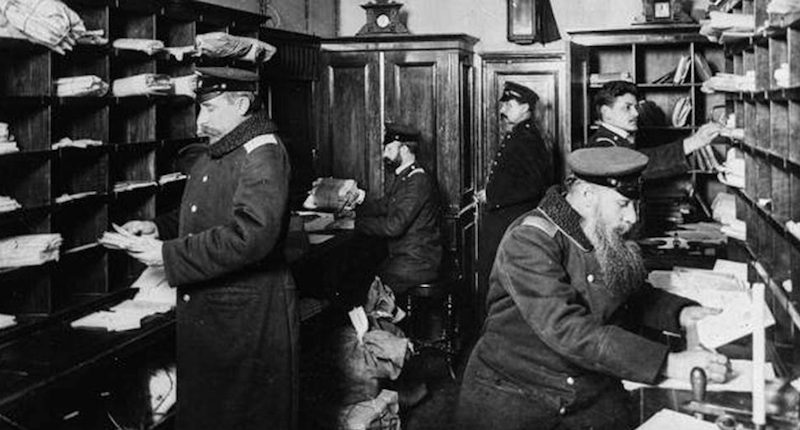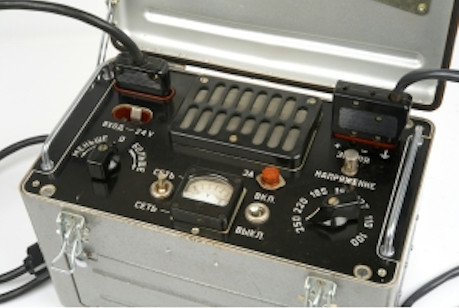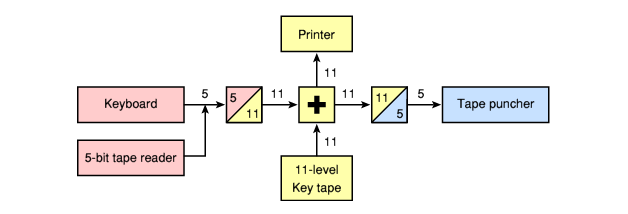A bit from the history of CCCP: M-105 cryptography, codenamed Agate
The history of cryptography dates back to the time of Ivan the Terrible. The first cryptographers used simple replacement ciphers, later, when Peter the Great, professional services involved in the encryption business began to appear. In the middle of 1700, the so-called "black offices" appeared - secret rooms in post offices where envelopes with letters were opened safely (sometimes not very). There was a concept - "perusal".

Post office at the post office in the Russian Empire
In the history of Russian cryptography of the times of the USSR, many gaps formed, since the information was under seven locks and was strictly kept secret. Some points are highlighted in the article is a treasury of domestic cryptography , it also mentioned the most famous Soviet cryptographic machines.
M-105 (code name: Agat) is a Russian, autonomous encryption machine that was developed and created in the USSR in the late 1960s. The predecessor of this crypto machine was almost identical to the M-104 (Amethyst and Amethyst-2). Such machines were used by all countries of the Warsaw Pact (GDR, Czechoslovakia, Hungary, Romania, Yugoslavia), they were electromechanical encoders of text information written on paper punched tape: SM-1 Vasilek, SM-2, M-104 Amethyst, M-105 Agat , M-125 Violet , M-130 Coral.

SM-1 Cornflower

M-104 Amethyst

M-105 Agate

M-125 Violet

M-130 Coral
M-105 Agate is a cryptographic machine that used OTT - One-Time-Tape encryption, the essence of this encryption is simple: the key used is one-time and is equal in length to the transmitted data, the text is encrypted and no one can decrypt it without the key.
Unlike Violet, in which 10 cryptographic wheels (rotors) were used to generate the key, the M-105 has a built-in mechanical key generator that outputs random keys to an 11-level punched tape. It is located at the top of the machine.

At first glance, the car is somewhat reminiscent of the M-125 Violet. An electric car, almost the same size, is painted in silver gray with a keyboard in Latin / Cyrillic. But the similarity ends here.
The M-105 displayed the results directly on a piece of paper that was in the back of the carriage. The advanced dot matrix print head made it possible to print any of 30 characters (5 x 6). Depending on the language used for printing, some characters or numbers may be missing.
At the back on the right was a device for inserting punched tape and key input (standard 5-level punched tape), though the Bodo code was not used.
Instead, the same coding scheme was used as in Violet. In front of the M-105 was a paper punched reader. The punched tape was guided through a ruler that ran across the entire width of the machine. To start and stop - two keys (Start, Stop) located on the front right.

The image below shows the location of the full keyboard: on each key - the letter of the Cyrillic alphabet and Latin letters. 30 keys, a black one-step key at the bottom left and a black control symbol for returning the CR / LF cutter at the bottom right, there is a space (bottom).

In encryption mode, a space was used when entering text, and the Y2 key was blocked. In decryption mode, the opposite is true: the space bar is locked, the Y2 key is available. When the machine was used in plain text mode (MODE is set to “O”), it was possible to use both the space bar and the Y2 key. Two black keys ("step" and CR / LF) are not encrypted. They only worked in text mode to format output. The missing “Y” can be easily replaced with an “I”. Identical to Violet, on the M-105 keyboard there are only 30 of the most used letters.
Punctuation marks - except for the SPACE character with the "» "in the upper left corner - no. Switching between Latin and Cyrillic meant replacing the print head.
The punched tape could be used for encryption only once, therefore, when switching the operating modes, the Control Hole was pierced. Decryption-only punched tapes had a Check Hole so that they would not be used randomly as an encryption key.

On the left front, right above the keyboard, there is a black rotary knob, with it you can select the desired operating mode: “O” for typing (Clear text), “3” for encryption (encrypt) and “P” for decryption (decrypt).

In text mode, the M-105 functioned like a regular typewriter or teleprinter and was used to print text, create 5-level punched tapes (5 holes per line). All keys were available, including space bar, carriage STEP, and CR / LF.
When setting encryption modes (3) or decryption (P), a number of mechanical changes occurred inside the device. As it was written earlier - in the encryption mode, the Y2 key is locked, a space is available, in decryption mode - the opposite is true.
The abbreviations used for the different modes are identical for all machines (M-125 or M-130), as shown below.


On the front of the 11-level key reader is a lever with three possible settings: P, PC and K. It was used to select the destination (punch, printer, punch and printer) encoded, decoded or plain text output.

There were several versions of M-105, the most common one - the device was powered from a 24 V DC source.

Specially, for connecting to a 110 V DC network, a different version of AGAT was available.



The standard power supply, which was used in the M-105, was suitable for networks of any voltage level (usually in the voltage range 110 - 220 V), could be used almost anywhere in the world. The same power supply was used with the M-125 Violet in most countries of the Warsaw Pact.

The lever performed several functions. With it, you could work with the machine manually in the event of a power failure. Since the encryption process was purely mechanical in nature, the machine could read 5-level punched tapes, tapes with keys, printed on paper and without electricity. The lever was also used to “reset” the mechanism if it jammed.

Lever
The M-105 used a 5 x 6 matrix (5 rows, 6 columns) to address 30 characters. Each 5-bit character was translated into a row (6 bits) and a column (5 bits), as a result, 11 internal “bits” were obtained, therefore, the key punched tape is 11-level.

An 11-bit code from the key punched tape was added to the 11-bit data stream, the result was then converted back to a 5-bit digital code (displayed on five-level punched cards).

In East Germany (DDR), the M-105 was commissioned in 1968 and was used to communicate with the Warsaw Pact partner states, as well as the GDR leadership, to exchange messages at the highest government level.
In 1986, the M-105 became a fully electronic M-205 D machine, but many M-105 remained in operation until the German reunion. The M-105 was replaced by the T-353 (Dudek) in 1987 for communication between the GDR and Hungary.

T-353 (Dudek)
Finding materials about this crypto machine on the Internet is extremely difficult, because the information was taken here: Crypto museum and bplaced.net. Most likely, such meager public coverage of achievements in the field of cryptography of the times of the USSR is due to a number of reasons: only partial declassification, underfunding and other problems. Let's hope that in the near future, domestic scientific achievements and outstanding cryptographers of the country will come out of the heading "top secret".
As an advertisement. Stock! Only now get up to 4 months of free use of VPS (KVM) with dedicated drives in the Netherlands and the USA (configurations from VPS (KVM) - E5-2650v4 (6 Cores) / 10GB DDR4 / 240GB SSD or 4TB HDD / 1Gbps 10TB - $ 29 / month and above, options with RAID1 and RAID10 are available) , a full-fledged analogue of dedicated servers, when ordering for a period of 1-12 months, the terms of the action are here,Existing subscribers can get a 2 month bonus!
How to build the infrastructure of the building. class using Dell R730xd E5-2650 v4 servers costing 9,000 euros for a penny?

Post office at the post office in the Russian Empire
In the history of Russian cryptography of the times of the USSR, many gaps formed, since the information was under seven locks and was strictly kept secret. Some points are highlighted in the article is a treasury of domestic cryptography , it also mentioned the most famous Soviet cryptographic machines.
M-105: Codenamed Agate
M-105 (code name: Agat) is a Russian, autonomous encryption machine that was developed and created in the USSR in the late 1960s. The predecessor of this crypto machine was almost identical to the M-104 (Amethyst and Amethyst-2). Such machines were used by all countries of the Warsaw Pact (GDR, Czechoslovakia, Hungary, Romania, Yugoslavia), they were electromechanical encoders of text information written on paper punched tape: SM-1 Vasilek, SM-2, M-104 Amethyst, M-105 Agat , M-125 Violet , M-130 Coral.

SM-1 Cornflower

M-104 Amethyst

M-105 Agate

M-125 Violet

M-130 Coral
M-105 Agate is a cryptographic machine that used OTT - One-Time-Tape encryption, the essence of this encryption is simple: the key used is one-time and is equal in length to the transmitted data, the text is encrypted and no one can decrypt it without the key.
Unlike Violet, in which 10 cryptographic wheels (rotors) were used to generate the key, the M-105 has a built-in mechanical key generator that outputs random keys to an 11-level punched tape. It is located at the top of the machine.

At first glance, the car is somewhat reminiscent of the M-125 Violet. An electric car, almost the same size, is painted in silver gray with a keyboard in Latin / Cyrillic. But the similarity ends here.
The M-105 displayed the results directly on a piece of paper that was in the back of the carriage. The advanced dot matrix print head made it possible to print any of 30 characters (5 x 6). Depending on the language used for printing, some characters or numbers may be missing.
At the back on the right was a device for inserting punched tape and key input (standard 5-level punched tape), though the Bodo code was not used.
The Bodo code is a uniform 5-bit telegraph code that uses two distinct electrical signals.
Instead, the same coding scheme was used as in Violet. In front of the M-105 was a paper punched reader. The punched tape was guided through a ruler that ran across the entire width of the machine. To start and stop - two keys (Start, Stop) located on the front right.

The image below shows the location of the full keyboard: on each key - the letter of the Cyrillic alphabet and Latin letters. 30 keys, a black one-step key at the bottom left and a black control symbol for returning the CR / LF cutter at the bottom right, there is a space (bottom).

In encryption mode, a space was used when entering text, and the Y2 key was blocked. In decryption mode, the opposite is true: the space bar is locked, the Y2 key is available. When the machine was used in plain text mode (MODE is set to “O”), it was possible to use both the space bar and the Y2 key. Two black keys ("step" and CR / LF) are not encrypted. They only worked in text mode to format output. The missing “Y” can be easily replaced with an “I”. Identical to Violet, on the M-105 keyboard there are only 30 of the most used letters.
Punctuation marks - except for the SPACE character with the "» "in the upper left corner - no. Switching between Latin and Cyrillic meant replacing the print head.
The punched tape could be used for encryption only once, therefore, when switching the operating modes, the Control Hole was pierced. Decryption-only punched tapes had a Check Hole so that they would not be used randomly as an encryption key.

Switching operating modes
On the left front, right above the keyboard, there is a black rotary knob, with it you can select the desired operating mode: “O” for typing (Clear text), “3” for encryption (encrypt) and “P” for decryption (decrypt).

In text mode, the M-105 functioned like a regular typewriter or teleprinter and was used to print text, create 5-level punched tapes (5 holes per line). All keys were available, including space bar, carriage STEP, and CR / LF.
When setting encryption modes (3) or decryption (P), a number of mechanical changes occurred inside the device. As it was written earlier - in the encryption mode, the Y2 key is locked, a space is available, in decryption mode - the opposite is true.
The abbreviations used for the different modes are identical for all machines (M-125 or M-130), as shown below.


On the front of the 11-level key reader is a lever with three possible settings: P, PC and K. It was used to select the destination (punch, printer, punch and printer) encoded, decoded or plain text output.
Power Supply

There were several versions of M-105, the most common one - the device was powered from a 24 V DC source.

Specially, for connecting to a 110 V DC network, a different version of AGAT was available.



The standard power supply, which was used in the M-105, was suitable for networks of any voltage level (usually in the voltage range 110 - 220 V), could be used almost anywhere in the world. The same power supply was used with the M-125 Violet in most countries of the Warsaw Pact.

The lever performed several functions. With it, you could work with the machine manually in the event of a power failure. Since the encryption process was purely mechanical in nature, the machine could read 5-level punched tapes, tapes with keys, printed on paper and without electricity. The lever was also used to “reset” the mechanism if it jammed.

Lever
The M-105 used a 5 x 6 matrix (5 rows, 6 columns) to address 30 characters. Each 5-bit character was translated into a row (6 bits) and a column (5 bits), as a result, 11 internal “bits” were obtained, therefore, the key punched tape is 11-level.

An 11-bit code from the key punched tape was added to the 11-bit data stream, the result was then converted back to a 5-bit digital code (displayed on five-level punched cards).

In East Germany (DDR), the M-105 was commissioned in 1968 and was used to communicate with the Warsaw Pact partner states, as well as the GDR leadership, to exchange messages at the highest government level.
In 1986, the M-105 became a fully electronic M-205 D machine, but many M-105 remained in operation until the German reunion. The M-105 was replaced by the T-353 (Dudek) in 1987 for communication between the GDR and Hungary.

T-353 (Dudek)
Finding materials about this crypto machine on the Internet is extremely difficult, because the information was taken here: Crypto museum and bplaced.net. Most likely, such meager public coverage of achievements in the field of cryptography of the times of the USSR is due to a number of reasons: only partial declassification, underfunding and other problems. Let's hope that in the near future, domestic scientific achievements and outstanding cryptographers of the country will come out of the heading "top secret".
As an advertisement. Stock! Only now get up to 4 months of free use of VPS (KVM) with dedicated drives in the Netherlands and the USA (configurations from VPS (KVM) - E5-2650v4 (6 Cores) / 10GB DDR4 / 240GB SSD or 4TB HDD / 1Gbps 10TB - $ 29 / month and above, options with RAID1 and RAID10 are available) , a full-fledged analogue of dedicated servers, when ordering for a period of 1-12 months, the terms of the action are here,Existing subscribers can get a 2 month bonus!
How to build the infrastructure of the building. class using Dell R730xd E5-2650 v4 servers costing 9,000 euros for a penny?
